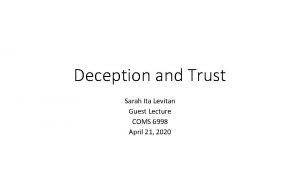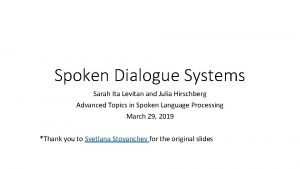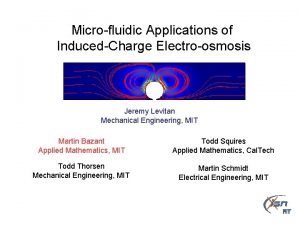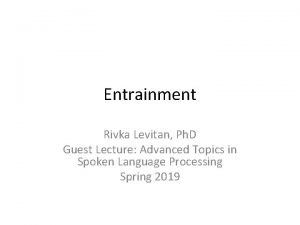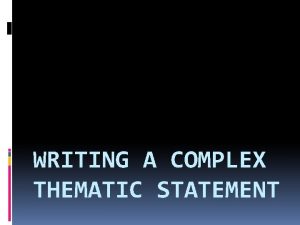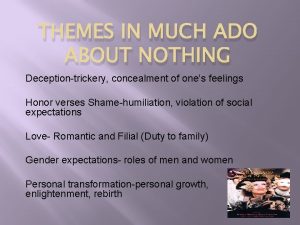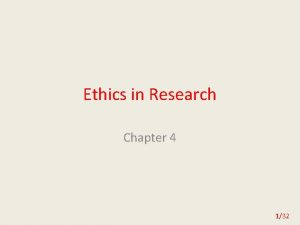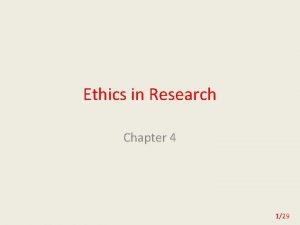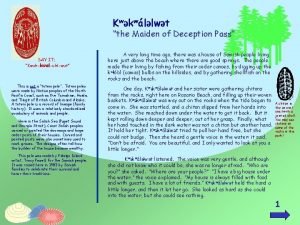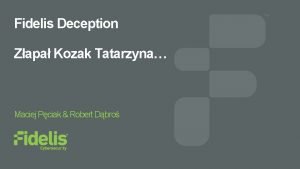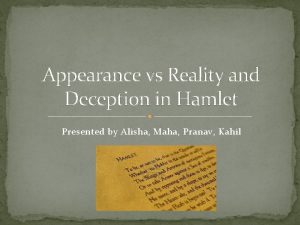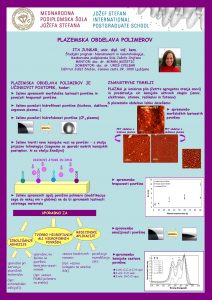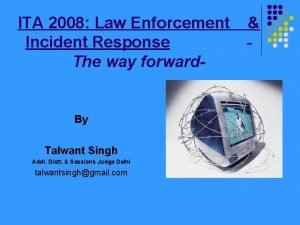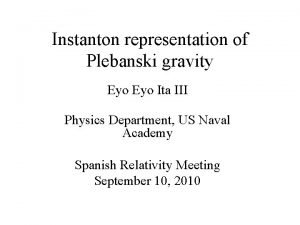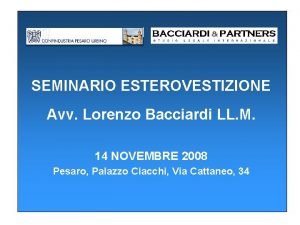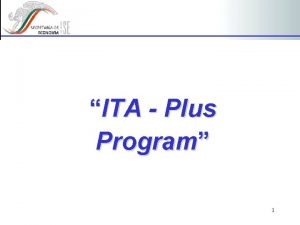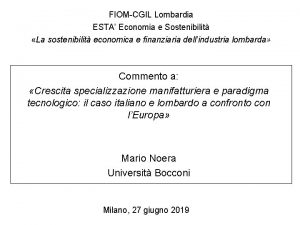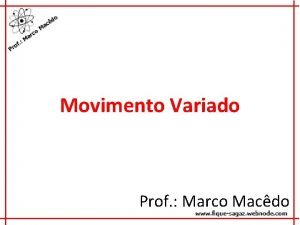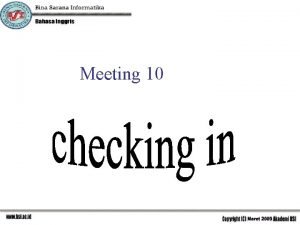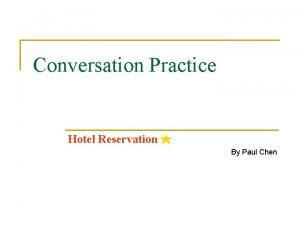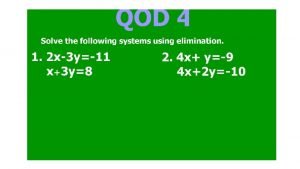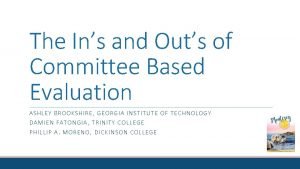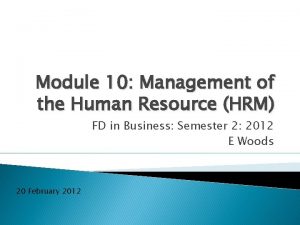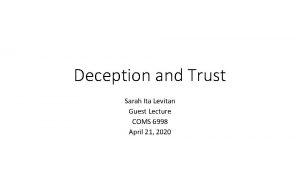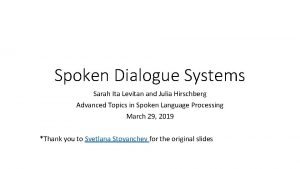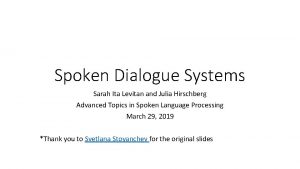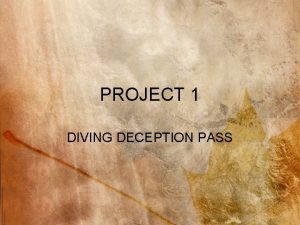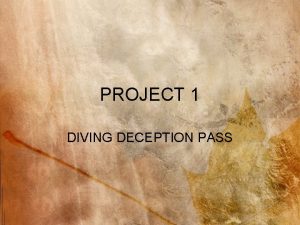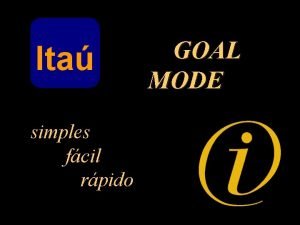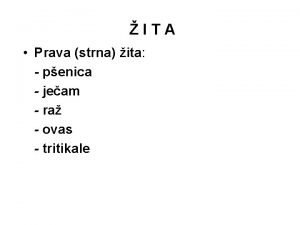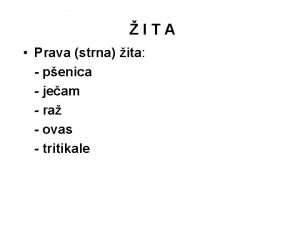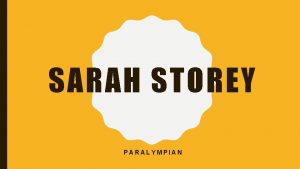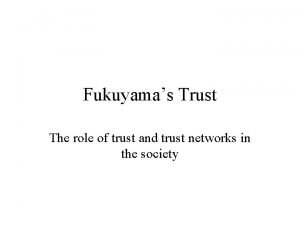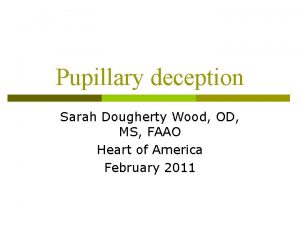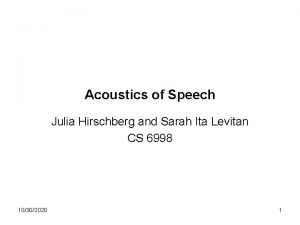Deception and Trust Sarah Ita Levitan Guest Lecture

































































- Slides: 65

Deception and Trust Sarah Ita Levitan Guest Lecture COMS 6998 April 21, 2020

Spoken language processing aims to teach computers to understand generate speech. 2

3

What can we convey and perceive from speech? • Gender • Age • Native language • Ethnicity • Personality • Physical health • Mental health • Charisma • Likeability • Emotion • Sarcasm • Humor • Deception • Trust 4

What can we automatically learn about speaker states and traits from their speech? 5

What can we automatically learn about speaker states and traits from their speech? And how can we leverage this information to improve human-computer interactions? 6

Entrainment in Supreme Court oral arguments Age and gender detection in call center dialogues Analysis and classification of trust in written news Acoustic event detection in You. Tube videos Linguistic cues to mental health from social media Deception detection in interview dialogues Analysis and classification of trustworthy speech 7

Deception Trust 8

Deception Trust What are the characteristics of deceptive and truthful speech? What makes humans perceive speech as truthful, or trust speech? Can we automatically detect deceptive and trustworthy speech? 9

10

Human performance at deception detection is about 50% -> random chance. 11

Human performance at deception detection (Aamodt & Mitchell, 2004; Hartwig et al. , 2017) Group # Studies # Subjects Accuracy % Criminals 1 52 65. 40 Secret service 1 34 64. 12 Psychologists 4 508 61. 56 Judges 2 194 59. 01 Police officers 8 511 55. 16 Federal officers 4 341 54. 54 122 8, 876 54. 20 Detectives 5 341 51. 16 Investment professionals 1 215 49. 4 Parole officers 1 32 40. 42 Students 12

Modalities • Body posture and gestures (Burgoon et al, ‘ 94) • Facial expressions (Ekman, ‘ 76; Frank, ‘ 03) • Biometric factors (Horvath, ‘ 73) • Brain imaging technologies (Bles & Haynes, ‘ 08) • Language-based • Text (Adams, ’ 96, Pennebaker et al. , ‘ 01) • Speech (Enos et al. , ‘ 06) 13

Language-based deception detection Practitioners Statement analysis Text Depositions (Adams, 1996) (Bachenko et al. 2008) Speech Voice Stress Analysis SCAN (Smith, 2001) Reid & Associates Hotel reviews (Ott et al. 2011) Streeter et al. (1977) Ekman et al. (1991) Enos (2009) (Buckley, 2000) Forensic linguists Crowd workers (Perez-Rosas & Mihalcea, 2015) (Horvath, 1982) 14

Challenges Data Ground truth annotation Laboratory vs. real-world deception Individual and cultural differences 15

Outline • Columbia X-Cultural Deception (CXD) Corpus • Deception detection from text and speech • Acoustic-prosodic and lexical analysis • Machine learning deception classification • Crowdsourced study of deception perception • Acoustic-prosodic and lexical analysis • Machine learning trust classification 16

Columbia X-Cultural Deception Corpus NEO-FFI Survey Lying game Biographical Questionnaire Survey Baseline 17

Columbia X-Cultural Deception Corpus >120 hours of subject speech 340 subjects Cross-cultural Fake resume paradigm NEO-FFI personality scores Baseline sample Financial incentive Lie production/perception Global/local deception labels 18

Units of analysis IPU Pause-free segment of speech from a single speaker Turn Sequence of speech from one speaker without intervening speech from the other speaker Question response Interviewee turn following an interviewer biographical question Question chunk Set of interviewee turns responding to an interviewer biographical question and subsequent follow-up questions 19

Units of analysis Unit IPU Turn Question Response Question Chunk Interviewer 81536 41768 8092 Interviewee 111428 43673 8092 Total 192964 85459 16184 20

“Have you ever tweeted? ” TRUE or FALSE? 21

“Have you ever tweeted? ” 22

Outline • Columbia X-Cultural Deception (CXD) Corpus • Deception detection from text and speech • Identifying acoustic-prosodic and linguistic cues to deception • Machine learning deception classification • Crowdsourced study of deception perception • Acoustic-prosodic and lexical analysis • Machine learning trust classification 23

Acoustic-prosodic and linguistic characteristics of deception and truth Four feature sets • • Acoustic-prosodic (Praat; Boersma et al. , 2002) Linguistic Deception Indicators (LDI) Linguistic Inquiry and Word Count (LIWC; Pennebaker et al. , 2015) Complexity (Lu, 2010) Two units of analysis • Question response • Question chunk Paired t-tests; FDR correction, �=0. 05 24

Acoustic-prosodic and Lexical Features (152) Acoustic-prosodic (8) pitch {max, mean}, intensity {max, mean}, speaking rate, jitter, shimmer NHR LDI (28) hedge words, filled pauses, contractions, denials, laughter, DAL (Dictionary of Affect in Language; Whissel et al. , 1986), specificity (Li & Nenkova, 2015) LIWC (93) word counts for semantic classes – linguistic, markers of psychological processes, punctuation, formality Complexity (23) measures of syntactic complexity (e. g. clauses per sentence, coordinate phrases per clause) 25

Acoustic-prosodic characteristics Pitch max Pitch mean Intensity max Intensity mean Speaking rate Jitter Shimmer NHR Increased pitch Ekman et al. (1976) Streeter et al. (1977) De. Paulo et al. (2003) Increased intensity De. Paulo et al. (2003) – no effect 26

Linguistic Deception Indicators (LDI) has. Absolutely. Really has. Contraction has. I has. We has. Yes has. NApos. T has. Not is. Just. Yes is. Just. No no. Yes. Or. No specific. Denial third. Person. Pronouns has. False. Start has. Filled. Pause num. Filled. Pauses has. Cue. Phrase num. Cue. Phrases has. Hedge. Phrase num. Hedge. Phrases has. Laugh num. Laugh DAL. wc DAL. pleasant DAL. activate DAL. imagery spec. Scores 27

Linguistic Inquiry and Word Count (LIWC) Adj Adverb Affect Affiliation Analytic Apostro Article Assent Authentic Auxverb Bio Clout Cogproc Compare Conj Dic Differ Drives Family Focuspast Focuspres Function I Informal Insight Ipron Negate Netspeak Nonflu Number Posemo Ppron Prep Pronoun Relative Sixltr Social Space tentat Time Tone Verb WC Work WPS 28

Complexity W words VP verb phrase C clauses T t-units DC dep. clause CT complex t-unit CP coordinate phrase CN complex nominal MLS mean length sentence MLT mean length t-unit MLC mean length clause C. S clauses/sentence VP. T verb phrases/t-unit C. T clauses/t-unit DC. C dep clauses/clause DC. T dep clauses/t-unit T. S t-units/sentence CT. T complex t-units/t-unit CP. T coord phrases/t-unit CP. C coord phrases/clause CN. T complex nom/t-unit CN. C complex nom/clause 29

Entrainment Phenomenon of interlocutors becoming similar to each other in conversation Associated with task success, likeability, trust Research questions: Do interlocutors entrain in deceptive dialogues? Are there differences in entrainment behavior between truthful and deceptive dialogues? 30

Entrainment 5 measures of global and local entrainment Local proximity, convergence, synchrony Global proximity, convergence 8 acoustic-prosodic features pitch {max, mean}, intensity {max, mean}, speaking rate, jitter, shimmer NHR 4 lexical features {100, 25} high frequency words, hedge words/phrases, cue phrases 31

Entrainment results Local entrainment Proximity: all acoustic features except pitch max Convergence: intensity {mean, max}, speaking rate, voice quality Synchrony: all acoustic features Global entrainment Proximity: high frequency words, hedge words, intensity {mean, max}, speaking rate, voice quality Convergence: high frequency words -> Evidence of acoustic-prosodic and lexical entrainment in deceptive dialogues, at global and local levels 32

Entrainment (local proximity) Pitch max Pitch mean Intensity max Intensity mean Speaking rate Jitter Shimmer NHR 33

Summary: acoustic-prosodic and linguistic characteristics of deception and truth Deception Increased pitch & intensity max Poor speech planning Descriptive, detailed Complex Hedge Entrainment Truth Negation Cue phrases Cognitive process Function words 34

Automatic deception detection Four units of analysis: IPU, turn, question response, question chunk Four statistical classifiers: Random Forest, Logistic Regression, SVM, Naïve Bayes Three neural network classifiers: DNN, LSTM, Hybrid Three feature sets: Acoustic (A), Lexical (L), Syntactic (S) Evaluation metric: Baselines: F 1 = Random: 50% accuracy Human: 56. 75% accuracy (question chunk units) 35

Logistic Regression 36

Hybrid: BLSTM-lexical + DNN-acoustic 37

Deception classification 70 Avg. F 1 65 IPU 60 55 50 Acoustic Lexical Syntactic A+L A+S L+S All 38

Deception classification 70 Avg. F 1 65 IPU 60 Turn 55 50 Acoustic Lexical Syntactic A+L A+S L+S All 39

Deception classification 70 Avg. F 1 65 IPU Turn 60 Qresponse 55 50 Acoustic Lexical Syntactic A+L A+S L+S All 40

Deception classification 70 Avg. F 1 65 IPU Turn 60 Qresponse Qchunk 55 50 Acoustic Lexical Syntactic A+L A+S L+S All 41

Deception classification 70 Avg. F 1 65 IPU Turn 60 Qresponse Qchunk 55 50 Acoustic Lexical Syntactic A+L A+S L+S All 42

Deception Trust What are the characteristics of deceptive and truthful speech? What makes humans perceive speech as truthful, or trust speech? Can we automatically detect deceptive and trustworthy speech? 43

Outline • Columbia X-Cultural Deception (CXD) Corpus • Deception detection from text and speech • Acoustic-prosodic and lexical analysis • Machine learning deception classification • Crowdsourced study of deception perception • Acoustic-prosodic and lexical analysis • Machine learning trust classification • Conclusions and future work 44

Lie. Catcher 45

46

Crowdsourcing Study • 5, 340 utterances • 3 judgments per utterance • 431 unique annotators • 38. 9% male, 59. 1% female, 2. 1% unreported 47

Lie Detection Ability • Overall accuracy = 49. 93% • Fleiss’ kappa: 0. 135 • Truth bias – 65% trusted • Truth Default Theory (T. R. Levine, 2014) 48

Features Examined • Disfluency “um…er” • Complexity more words, more detailed • Affect sentiment • Uncertainty “sort of”, “probably” • Creativity difference from “standard” responses for same question • Prosody pitch, speaking rate, loudness 49

Disfluency Features Has filled pause # filled pause Response latency Trust ↓↓↓↓ Deception ↑↑↑↑ Repetition False start ↓↓↓↓ ↑ ↑↑ ↓ indicates negative relationship; ↑ indicates positive relationship ↓: <. 05, ↓↓ : <. 01, ↓↓↓ : <. 001, ↓↓↓↓ : <. 0001 50

Prosody Features Speaking rate Pitch max Pitch mean Trust ↑↑↑↑ ↑↑ Deception Pitch std Intensity max Intensity mean Intensity std Jitter, shimmer, nhr ↑↑ ↑↑ ↑↑↑↑ ↓↓↓↓ ↑↑↑↑ ↑ ↓ indicates negative relationship; ↑ indicates positive relationship ↓: <. 05, ↓↓ : <. 01, ↓↓↓ : <. 001, ↓↓↓↓ : <. 0001 51

Characteristics of Successful Lies Features Duration Speaking rate Response latency Successful Lie ↓↓↓↓ ↑↑↑↑ ↓↓↓↓ Intensity mean Repetition Filled pauses ↑↑↑↑ ↓↓↓↓ 52

Analysis of strategies • Ask raters to provide strategies that they used • Annotate strategies by category • Investigate which strategies are useful 53

54

Does complex reasoning help? • How long do people take to make judgments? • no correlation between the response time and whether the answer is correct (spearman, ρ=0. 008, p>0. 05) • negative correlation between the response time and whether the answer is trusted (spearman, ρ=-0. 101, p<0. 0001) • How many strategies do people use? • no correlation between the number of strategies and the score (spearman, ρ=0. 029, p>0. 05) • a negative correlation between the percentage of utterances that annotators trust and the number of strategies they use (spearman, ρ=-0. 133, p<0. 01) 55

Can we predict trusted speech? • 5 -fold cross validation, speaker independent • Low agreement task -> only classify utterances with consensus • Logistic regression • Evaluate with macro-F 1 • Baseline (random): 44. 62 F 1 56

Can we predict trusted speech? • NLP Data-driven features • Glo. Ve embeddings • Dependency parse n-grams • Word n-grams • Hypothesized deception features • • Disfluency Complexity Prosody Speaker traits 57

Hypothesized deception features Speaker traits Complexity Prosody Disfluency NLP data-driven Random F 1 Trust classification results 70 65 60 55 50 45 40 35 30 58

Summary: Trusted Speech • Subjective task • Characteristics of trust vs. deception • Trust classification: 66. 62 F 1 • Why people are bad at lie detection: • Mismatch between features of trusted and truthful speech • Ineffective strategies reported 59

Ongoing/Future Work • Trusted speech: • Synthesize trustworthy voices, evaluate • Analyze discourse features • Trusted news: • Scale up to social media analysis 60

Contributions • Large-scale corpus of deceptive dialogues • Acoustic-prosodic and linguistic cues to deception • Automatic deception classification: >70% accuracy • Crowdsourced study of deception perception • Identified characteristics of trusted speech • Predictive models for trusted speech detection 61

Multimodal Real-World Deception Detection 62

Publications Acoustic-prosodic and lexical cues to deception and trust: Deciphering how people detect lies. X. Chen, S. I. Levitan, M. Levine, M. Mandic, J. Hirschberg. TACL 2020. Acoustic-prosodic indicators of deception and trust in interview dialogues. S. I. Levitan, A. Maredia, J. Hirschberg. Interspeech 2018. Deep personality recognition for deception detection. G. An, S. I. Levitan, J. Hirschberg, R. Levitan. Interspeech 2018. Acoustic-prosodic and lexical entrainment in deceptive dialogue. S. I. Levitan, J. Xiang, J. Hirschberg. Speech Prosody 2018. Linguistic cues to deception and perceived deception in interview dialogues. S. I. Levitan, A. Maredia, J. Hirschberg. NAACL 2018. Lie. Catcher: game framework for collecting human judgments of deceptive speech. S. I. Levitan, J. Shin, I. Chen, J. Hirschberg. Games 4 NLP, LREC workshop 2018. 63

Publications Hybrid acoustic-lexical deep learning approach for deception detection. G. Mendels, S. I. Levitan, K. Z. Lee, J. Hirschberg. Interspeech 2017. Combining acoustic-prosodic, lexical, and phonotactic features for automatic deception classification. S. I. Levitan, G. An, M. Ma, R. Levitan, A. Rosenberg, J. Hirschberg. Interspeech 2016. Automatically classifying self-rated personality scores from speech. G. An, S. I. Levitan, R. Levitan, A. Rosenberg, M. Levine, J. Hirschberg. Interspeech 2016. Identifying individual differences in gender, ethnicity, and personality from dialogue for deception detection. S. I. Levitan, Y. Levitan, G. An, M. Levine, R. Levitan, A. Rosenberg, J. Hirschberg. NAACL workshop CADD 2016. Cross-cultural production and detection of deception from speech. S. I. Levitan, G. An, M. Wang, G. Mendels, J. Hisrchberg, M. Levine, A. Rosenberg. ICMI WMDD 2015. Individual differences in deception and deception detection. S. I. Levitan, M. Levine, J. Hirschberg, N. Cestero, G. An, A. Rosenberg. Cognitive 2015. (Best paper award) 64

Thank you! Julia Hirschberg Michelle Levine Angel Maredia Jessica Xiang Arthur Shen Marco Mandic Eric Bolton Xi Chen William Wang James Shin 65
 Sarah ita levitan
Sarah ita levitan Sarah ita levitan
Sarah ita levitan Bazant
Bazant Lois levitan
Lois levitan Rivka levitan
Rivka levitan Complex theme examples
Complex theme examples Much ado about nothing motifs
Much ado about nothing motifs Macbeth prophecy
Macbeth prophecy The art of deception by kevin mitnick
The art of deception by kevin mitnick Passive deception
Passive deception Active vs passive deception
Active vs passive deception Deceit in jane eyre
Deceit in jane eyre Deception pass proposal
Deception pass proposal Maiden of deception pass
Maiden of deception pass Tatarzyna
Tatarzyna Kingdom of deception
Kingdom of deception Appearance vs reality hamlet
Appearance vs reality hamlet Deception in a sentence
Deception in a sentence Ddo a lesson in deception
Ddo a lesson in deception 01:640:244 lecture notes - lecture 15: plat, idah, farad
01:640:244 lecture notes - lecture 15: plat, idah, farad Charitable work
Charitable work Counterbalance forklift ita classification
Counterbalance forklift ita classification Ita junkar
Ita junkar King from ita yemoo
King from ita yemoo King from ita yemoo
King from ita yemoo Ita 2008
Ita 2008 Eyo ita physics
Eyo ita physics Sepuluh tahun yang lalu umur ita dua kali umur tika
Sepuluh tahun yang lalu umur ita dua kali umur tika Ita
Ita Ita skin
Ita skin Ita plus
Ita plus Ita
Ita Ita
Ita Sottotitoli ita
Sottotitoli ita Ita corpbanca
Ita corpbanca A borda de um precipicio de um certo planeta
A borda de um precipicio de um certo planeta Dd ita
Dd ita Ita
Ita How did the valet prepare guest clothes
How did the valet prepare guest clothes Dialogue receptionist and guest
Dialogue receptionist and guest Greets and assists guests arriving at the hotel
Greets and assists guests arriving at the hotel Reservation in hotel conversation
Reservation in hotel conversation Greet the guest
Greet the guest Guest laundry docket
Guest laundry docket Generic term for the guest room sheets and pillowcases
Generic term for the guest room sheets and pillowcases Sarah is selling bracelets and earrings
Sarah is selling bracelets and earrings Genesis 21:15-16
Genesis 21:15-16 Sarah and pam often go to parties
Sarah and pam often go to parties Figurative language trashketball
Figurative language trashketball Wellness and wellbeing with sarah glasgow
Wellness and wellbeing with sarah glasgow Abraham and sarah
Abraham and sarah Committee based evaluation
Committee based evaluation Sarah and angelina grimke apush
Sarah and angelina grimke apush Etihad guest email
Etihad guest email Wireless guest access solution
Wireless guest access solution Welcome to our honorable guests
Welcome to our honorable guests Archie smith boy wonder picture
Archie smith boy wonder picture Welcome address for webinar sample
Welcome address for webinar sample Meraki splash page collect email
Meraki splash page collect email Don't boast about yourself
Don't boast about yourself Apa itu guest ledger
Apa itu guest ledger Accept housekeeping request from guest
Accept housekeeping request from guest Guest pfp
Guest pfp Engagement zone utrgv
Engagement zone utrgv Nasa guest account
Nasa guest account Guest model of hrm
Guest model of hrm
